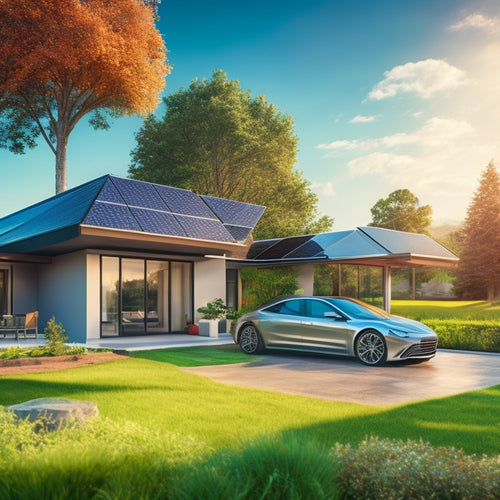
A 7-Step Guide to Installing Solar Panels on Your Home
Share
You're about to change your home's energy environment by installing solar panels! To get started, assess your home's solar potential by evaluating sunlight exposure, roof size, and orientation, and trim trees or remove obstructions to optimize energy capture. Next, determine your energy needs and consumption patterns by reviewing past utility bills and conducting an energy audit. Then, choose the right solar panels based on efficiency, budget, and quality, and select a reputable installer with the necessary certifications and experience. From there, prepare your roof for installation, install the solar panel system, connect to the grid, and monitor performance to guarantee you're maximizing your energy savings - and it's just the beginning of your solar adventure.
Key Takeaways
- Assess your home's solar potential by evaluating sunlight exposure, roof size, orientation, and shading to optimize energy production.
- Determine your energy needs and consumption patterns to identify the right solar panel system size and configuration for your home.
- Choose the right solar panels by considering factors such as efficiency, budget, and quality to ensure long-term performance and energy production.
- Select a reputable installer with certifications, good customer feedback, and experience to ensure a successful installation.
- Prepare your home's roof by assessing its condition, structural integrity, and obstructions to ensure a safe and efficient installation.
Assess Your Home's Solar Potential
Every hour, the sun beams down on your roof with enough energy to power your home for an entire day. However, not all homes are created equal when it comes to utilizing this energy. That's why a solar site assessment is vital to determine your home's solar potential.
During a solar site assessment, experts evaluate your home's sunlight exposure, considering factors like roof size, orientation, and shading.
They'll assess the amount of direct sunlight your roof receives throughout the day and identify any obstacles that might hinder energy production.
To maximize your solar potential, it's important to optimize your roof's sunlight exposure. This might involve trimming trees, removing obstructions, or adjusting the angle of your solar panels.
Determine Your Energy Needs
To determine the right size of your solar panel system, you'll need to calculate your current energy usage and identify patterns in your energy consumption.
Start by reviewing your past utility bills to get a sense of your average daily energy usage in kilowatt-hours (kWh).
You should also take note of your energy consumption patterns, such as peak usage times and seasonal variations.
Current Energy Usage
About 30% of your monthly energy bill goes toward powering appliances, lighting, and heating or cooling your home. To determine your energy needs, you need to understand your current energy usage. Conducting an energy audit can help you identify areas of inefficiency and opportunities for improvement.
This involves analyzing your past energy usage trends to identify patterns and anomalies. By reviewing your past bills, you can pinpoint which appliances and systems consume the most energy. This information will help you decide which areas to focus on when installing solar panels.
You may find that your energy usage peaks during certain times of the day or year, which can inform your solar panel installation strategy. Understanding your current energy usage is vital in determining the size and type of solar panel system you need.
This step will help you optimize your system to meet your specific energy needs, ensuring you get the most out of your investment.
Energy Consumption Patterns
By analyzing your past energy bills, you've likely uncovered some interesting patterns and trends in your energy consumption. This analysis is essential in determining your energy needs and identifying areas for improvement.
Take note of your peak usage hours, days, and seasons to understand when you consume the most energy. This information will help you optimize your solar panel installation for maximum energy efficiency.
Look for opportunities to adjust your consumption habits, such as shifting non-essential loads to off-peak hours or investing in energy-efficient appliances.
You may also want to take into account implementing smart home technologies to monitor and control your energy usage in real-time.
By understanding your energy consumption patterns, you can right-size your solar panel system to meet your specific needs, ensuring you generate enough power to meet your demands while minimizing excess energy production.
This careful planning will help you maximize your return on investment and achieve the energy independence you desire.
Choose the Right Solar Panels
When selecting solar panels for your home, you'll want to evaluate three key factors: panel efficiency, budget-friendliness, and quality.
You'll need to balance the benefits of high-efficiency panels with the cost savings of more affordable options.
Panel Efficiency Matters
Most homeowners investing in solar energy systems want to maximize their energy harvest. To do this, you need to choose the right solar panels. Panel efficiency matters, as it directly impacts how much energy your system can produce.
When evaluating panel technology, look for efficiency ratings. These ratings indicate how well a panel converts sunlight into electricity. High-efficiency panels typically have higher power output ratings and are often more expensive. However, they can be a good option if you have limited roof space or want to maximize energy production.
Efficiency ratings vary widely, ranging from around 15% to over 22%. While higher efficiency panels are available, they may not be necessary for most homeowners. A good starting point is to look for panels with efficiencies between 18% and 20%.
These offer a good balance between performance and cost. Remember, even small increases in efficiency can add up over time, resulting in more energy savings and a quicker return on your investment.
Budget-Friendly Options Exist
While high-efficiency panels can offer impressive performance, they may not be the best fit for every homeowner's budget. You don't have to break the bank to switch to solar power.
Look for cost-effective solutions that balance performance and affordability. Consider panels with lower efficiencies that can still provide reliable energy production at a lower upfront cost.
You may also want to investigate solar financing options, such as loans or power purchase agreements, which can help spread the cost over time.
Additionally, look for manufacturers that offer budget-friendly options without sacrificing quality. Some companies offer more affordable panels with similar warranties and performance guarantees as their higher-end counterparts.
Quality Over Quantity
Two key factors to evaluate when selecting the right solar panels for your home are durability and efficiency. You want solar panels that can withstand harsh weather conditions and generate maximum power output. With so many solar panel types available, choosing the right one can be overwhelming. However, by considering these two factors, you can make an informed decision.
| Solar Panel Type | Efficiency | Durability |
|---|---|---|
| Monocrystalline | High (20-22%) | Excellent (30-year warranty) |
| Polycrystalline | Medium (15-18%) | Good (25-year warranty) |
| Thin-Film | Low (7-14%) | Fair (20-year warranty) |
| Bifacial | High (20-24%) | Excellent (30-year warranty) |
| PERC | High (18-22%) | Excellent (30-year warranty) |
When it comes to installation techniques, consider the type of mounting system and tracking system used. A high-quality mounting system guarantees your solar panels are securely fastened to your roof, while a tracking system allows your panels to follow the sun's movement, increasing energy production. By prioritizing quality over quantity, you'll get more bang for your buck and enjoy a higher return on investment.
Select a Reputable Installer
You've narrowed down your solar panel options, and now it's time to find a reputable installer to bring your renewable energy vision to life. This is an essential step, as a qualified installer can make all the difference in the performance and longevity of your solar panel system.
Start by researching local installers and their qualifications. Look for certifications from reputable organizations such as the North American Board of Certified Energy Practitioners (NABCEP). A NABCEP-certified installer has demonstrated knowledge in designing and installing solar panel systems.
Next, read customer reviews to get a sense of the installer's work quality, communication, and customer service. Websites like Yelp, Angie's List, and Google Reviews can provide useful information.
Pay attention to the overall rating and read the reviews to identify any red flags. A reputable installer will have a high overall rating and few, if any, negative reviews.
Prepare Your Home's Roof
Prepare Your Home's Roof
Get ready to assess your roof's solar-friendliness by taking a closer look at its condition and suitability for solar panels. Before installing solar panels, you need to verify your roof is structurally sound and can support the added weight. Conduct a thorough roof inspection to identify any damaged, rotten, or missing shingles, curled or buckled shingles, and signs of animal or insect infestation.
| Roof Condition | Solar Panel Suitability |
|---|---|
| Age: 10-15 years | May require replacement before installation |
| Slope: 15-40 degrees | Ideal for solar panel installation |
| Material: Asphalt shingles | Compatible with solar panels |
| Obstructions: Skylights, vents, chimneys | May require additional installation costs |
A roof inspection will also help you identify potential issues that may affect the performance and longevity of your solar panel system. Confirm your roof has sufficient structural integrity to support the weight of the solar panels and withstand various weather conditions. Addressing any roof issues beforehand will prevent costly repairs down the line and guarantee a successful solar panel installation.
Install the Solar Panel System
With your roof now ready for solar panels, it's time to bring in the professionals to install the system.
They'll begin by evaluating your home's energy needs and determining the most suitable solar panel types for your roof. You may opt for monocrystalline, polycrystalline, or thin-film solar panels, depending on your budget, energy requirements, and roof size.
The installation team will then secure the necessary installation permits from your local authorities. These permits guarantee that your solar panel system meets local building codes and safety standards.
The team will also prepare your roof for the installation by cleaning and inspecting it for any damage or obstructions.
Next, they'll install the solar panel mounting system, which includes the racking and tracking components.
The solar panels will then be securely fastened to the mounting system, and the electrical connections will be made.
The team will also install an inverter to convert the DC power generated by the solar panels into AC power for your home.
Connect to the Grid
Connecting to the grid requires synchronizing your solar panel system with the utility company's electrical infrastructure. This step is essential to guarantee that your system operates safely and efficiently.
You'll need to establish a grid connection, which allows you to sell excess energy back to the utility company and offset your energy consumption.
To achieve a successful grid connection, you'll need to:
-
Obtain necessary permits: Secure approval from your utility company and local authorities to connect your solar panel system to the grid.
-
Install a grid tie inverter: This device synchronizes your solar panel system's output with the grid's frequency and voltage.
-
Meet utility company requirements: Verify your system meets the utility company's interconnection standards and regulations.
- Schedule a grid connection inspection: Arrange for a utility company representative to inspect your system and approve the grid connection.
Monitor and Maintain Performance
As your solar panel system begins generating electricity, monitoring and maintaining its performance becomes vital to confirm ideal energy production and longevity. You'll want to keep a close eye on your system's performance to verify it's producing the maximum amount of energy possible.
Performance monitoring typically involves tracking key metrics such as energy output, voltage, and temperature. This data can help you identify any potential issues and make adjustments to optimize performance.
Regular maintenance is also important to extend the lifespan of your solar panel system. Some fundamental maintenance tips include cleaning the panels regularly to remove dirt and debris, checking for loose connections, and inspecting the system for signs of wear and tear.
You should also keep an eye out for any error messages or alerts from your monitoring system, as these can indicate potential problems. By staying on top of performance monitoring and maintenance, you can verify your solar panel system continues to generate clean, renewable energy for years to come.
Take Advantage of Incentives
Since you've invested in a solar panel system, you're likely enthusiastic to maximize your return on investment.
Take advantage of the various incentives available to you to increase your energy savings.
-
Federal Incentives: The Solar Investment Tax Credit (ITC) allows you to claim a tax credit of 26% of your total solar panel system cost.
-
State Rebates: Many states offer rebates for solar panel installations, which can help offset the upfront cost.
-
Financing Options: Investigate financing options like solar loans or power purchase agreements (PPAs) that can help you save money on your energy bills.
- Utility Programs: Participate in utility programs like net metering, which allows you to sell excess energy back to the grid and offset your energy consumption.
Frequently Asked Questions
Can I Install Solar Panels on a Metal or Clay Tile Roof?
You'll need to evaluate metal roof factors, such as guaranteeing a secure mounting system, and verify clay tile compatibility, checking for fragility and weight capacity, to ascertain a safe and efficient solar panel installation on your unique roof type.
Will Solar Panels Work During a Power Outage?
When darkness falls, you're left powerless, but solar panels can be your guiding light. During a power outage, they won't work unless you have an off-grid system, ensuring solar panel efficiency; otherwise, they'll shut down for safety reasons, leaving you in the dark.
Do Solar Panels Increase My Home's Value?
You're likely to see a significant increase in your home's value thanks to your solar investment, which provides long-term energy savings, making your property more attractive to potential buyers and increasing its resale value.
Can I Install Solar Panels Myself to Save Money?
You can try a DIY installation to cut costs, but be aware that it's a complex process requiring electrical and roofing knowledge, and you might void your warranty, sacrificing long-term cost savings for short-term gains.
Will Solar Panels Void My Roof's Warranty?
You're not about to unwittingly sabotage your entire roof's warranty with a single solar panel installation mistake! Thankfully, most manufacturers won't void your roof warranty if you follow proper solar installation considerations, ensuring a harmonious coexistence between your roof and shiny new panels.
Related Posts
-

What Solar Panels Work Best With EVS Online?
When shopping for solar panels online to power your electric vehicle, look for high-efficiency models that can withst...
-

Top Online Stores for Solar Car Accessories
When searching online for solar car accessories, you'll find top retailers like Amazon, REI Co-op, and Best Buy offer...
-

Why Cities Need Smart Charging Infrastructure Now
You're about to experience a tidal wave of electric vehicles hitting your city's streets, and it's essential you're p...


